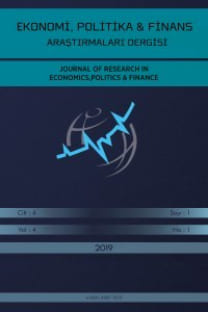Artan Kurumsal Kalite İşsizliği Azaltır mı? OECD Ülkelerinden Kanıtlar
işsizlik, yönetişim kalitesi, kurumsal altyapı, panel veri analizi
Does Increased Institutional Quality Reduce Unemployment? Evidence from OECD Countries
___
- Abé Ndjié, A., Atangana Ondoa, H., & Ngoa Tabi, H. (2019). Governance and youth unemployment in Africa. Labor History, 60(6), 869-882.
- Abrams, B. A. (1999). The effect of government size on the unemployment rate. Public choice, 99(3), 395-401.
- Acock, A. C. (2014). Working with missing values-multiple imputation. In a gentle introduction to Stata (Fourth edition). College Station, Texas, USA: Stata Press.
- Ades, A., & Di Tella, R. (1997). The new economics of corruption: a survey and some new results. Political Studies, 45(3), 496-515.
- Asongu, S. A., and Nnanna, J. (2019). Foreign aid, instability, and governance in Africa. Politics & Policy, 47(4), 807-848.
- Baltagi, B. H. and Wu, P. X. (1999). Unequally spaced panel data regressions with AR(1) disturbances. Econometric Theory, 15(6) 814-823. https://doi.org/10.1017/S0266466699156020
- Battaglini, M., and Coate, S. (2011). Fiscal policy and unemployment (No. w17562). National Bureau of Economic Research.
- Bhargava, A., Franzini, L. and Narendranathan, W. (1982). Serial correlation and the fixed effects model. The Review of Economic Studies, 49(4), 533-549. https://doi.org/10.2307/2297285
- Bouzid, B. N. (2016). Dynamic relationship between corruption and youth unemployment: empirical evidences from a system GMM approach. World Bank Policy Research Working Paper, (7842).
- Breusch, T. S. and A. R. Pagan. (1980). The Lagrange multiplier test and its applications to model specification in econometrics. Review of Economic Studies 47(1), 239–253. https://doi.org/10.2307/2297111
- Cleff, T. (2019). Applied statistics and multivariate data analysis for business and economics. Springer International Publishing.
- Çoban, S., and Topcu, M. (2013). The nexus between financial development and energy consumption in the EU: A dynamic panel data analysis. Energy Economics, 39, 81-88.
- Das, P. (2019). Econometrics in theory and practice: Analysis of cross section, time series and panel data with Stata 15.1. Singapore: Springer. https://doi.org/10.1007/978-981-32-9019-8
- Djankov, S., & Ramalho, R. (2009). Employment laws in developing countries. Journal of Comparative Economics, 37(1), 3-13.
- Dray, S., and Josse, J. (2015). Principal component analysis with missing values: a comparative survey of methods. Plant Ecology, 216(5), 657-667.
- Dreher, A., Kotsogiannis, C., & McCorriston, S. (2007). Corruption around the world: Evidence from a structural model. Journal of comparative economics, 35(3), 443-466.
- Driscoll, J. C. and Kraay, A. C. (1998). Consistent covariance matrix estimation with spatially dependent panel data. Review of Economics and Statistics, 80(4), 549-560. https://doi.org/10.1162/003465398557825
- Greene, W. (2000). Econometric analysis (Fourth edition). Englewood Cliffs: Prentice Hall.
- Hausman, J. A. (1978). Specification tests in econometrics. Econometrica, 46(6), 1251–1272. https://doi.org/10.2307/1913827
- Malik, A. H., bin Md Isa, A. H., bin Jais, M., Rehman, A. U., & Khan, M. A. (2022). Financial stability of Asian Nations: Governance quality and financial inclusion. Borsa Istanbul Review, 22(2), 377-387.
- Mark, J., & Nwaiwu, J. N. (2015). Impact of political environment on business performance of multinational companies in Nigeria. African Research Review, 9(3), 1-10.
- Mauro, P. (1998). Corruption and the composition of government expenditure. Journal of Public economics, 69(2), 263-279.
- N’Guessan, T. (2001). Bureaucracy and programme conditionality. African Development Review, 13(1), 6-25.
- Pesaran, M. H. (2004). General diagnostic tests for cross section dependence in panels (IZA Paper No. 1240). Retrieved from https://www.iza.org/en/publications/dp?page=1
- Salami, C. G. E. (2013). Youth unemployment in Nigeria: A time for creative intervention. International Journal of Business and Marketing Management, 1(2), 18-26.
- Schultz, T. P. (2000). Issues, Evidence, and Prospects. Economic policy reform: The second stage, 295.
- Sharma, S., 1996. Applied Multivariate Techniques. John Wiley and Sons, Inc., New York
- Tatoğlu, F. Y. (2016). Panel veri ekonometrisi Stata uygulamalı. Ankara: Beta Yayıncılık.
- Greene, W. (2000). Econometric analysis (Fourth edition). Englewood Cliffs: Prentice Hall.
- Hausman, J. A. (1978). Specification tests in econometrics. Econometrica, 46(6), 1251–1272. https://doi.org/10.2307/1913827
- Pesaran, M. H. (2004). General diagnostic tests for cross section dependence in panels (IZA Paper No. 1240). Retrieved from https://www.iza.org/en/publications/dp?page=1
- Tatoğlu, F. Y. (2016). Panel veri ekonometrisi Stata uygulamalı. Ankara: Beta Yayıncılık.
- World Bank. (2021). Worldwide Governance Indicators [Dataset]. Retrieved from http://info.worldbank.org/governance/wgi/
- Yayın Aralığı: Yılda 4 Sayı
- Başlangıç: 2016
- Yayıncı: Ersan ERSOY
Mali Kuralların ve Siyasi Yapının Etkileri: COVID-19 Krizinden Kanıtlar
Erdem KILIÇ, Sıtkı SÖNMEZER, Orhan ÖZAYDIN
Yeşil Tahvil ile Pay Piyasaları Arasındaki İlişkinin Çapraz Kantilogram Yöntemi ile Analizi
İlk Halka Arzların BİST100 Endeksi Volatilitesine Etkisi: Covid-19 Pandemisi Dönemi
Seçil BAYRAKTAR YETİM, Ayben KOY
Kripto Paralarla Borsalar Arasındaki Volatilite Yayılımı
Zekai ŞENOL, Tuba GÜLCEMAL, Oğuz ÇAKAN
Ayşegül TOY, Ayhan KAPUSUZOĞLU, Nildağ Başak CEYLAN
Ayşegül ERTUĞRUL AYRANCI, Gizem ARI
Ekonomik Özgürlükler İndeks Göstergelerinin Yeni Sanayileşen Ülkelerin Kredi Notları Üzerine Etkisi
Gizem VERGİLİ, Mehmet Sinan ÇELİK, Bahar TAŞ
Artan Kurumsal Kalite İşsizliği Azaltır mı? OECD Ülkelerinden Kanıtlar
